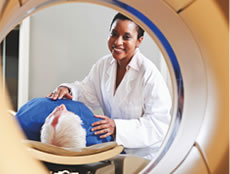
|
Since the discovery of x-rays in 1895, better and faster ways to look inside the body without using surgery have been developed. The common x-ray machine has been joined by CT scanners, ultrasound systems, and Magnetic Resonance Imaging devices. All of these provide pictures of internal organs and structures to assist your doctor in making a diagnosis and in planning treatment. MRI studies use radio waves and a strong magnetic field to produce very clear, multi-layered pictures of bones, organs, and tissues.
There are no special steps for you to follow before your MRI exam. Unless your doctor tells you differently, you may eat and drink as usual, and take whatever medications you need. Please bring this brochure to your MRI exam. If you tend to become claustrophobic (fear of enclosed or small spaces), you may wish to request a mild sedative from your personal doctor. Or, if you notify us in advance, we can provide a sedative when you arrive for your MRI. If you are going to be sedated, arrange to have someone drive you to and from your appointment. Depending on the part of your body being studied, the length of the exam will vary. MRI studies usually require 30 to 60 minutes. Additional imaging studies will increase the time needed.
When you arrive for your appointment, you will be asked a series of questions about your medical history. Please be sure to tell the technologist if you have a pacemaker, surgical clips (especially in your brain), prosthesis (artificial limb, etc.), or any type of metal object in your body. It is also very important to know if you have ever had a penetrating eye injury at any time in your life. And, if you are pregnant or think you might be, please tell the technologist.
You will be taken to a dressing room. You will be asked to change into the exam gown provided, and remove all materials that might be affected by the magnet – such as your watch, jewelry, credit cards, keys, coins and hairpins. These items will be stored in a safe place until your study is completed.
When you are ready, you will be escorted into the scan room. The technologist will explain the procedure and answer your questions. Then, you will be assisted onto the exam table and positioned for the study. If you are having an MRI of your brain, you will be asked to wear a special helmet. As theprocedure begins, the table will move slowly into the magnetic opening. All you need to do is relax and remain as still as possible. You may feel vibrations,and you will hear noises made by the machine during scanning. We will offer you earplugs, or will play music to muffle the sound. For some studies, an injection of contrast material may be required. It will pass though your body within hours. There is an intercom in the scan room. So, if you become uncomfortable or need help, just call for the technologist.
Remember: you will experience no discomfort during this examination, and there are no side effects. Unless you received a sedative, you will be able to drive, return to work, and resume all your normal activities when your MRI exam is complete. The images acquired during this procedure will be reviewed by a Radiologist, who will then report the results to your doctor. Your doctor will discuss the results with you at your next appointment.
Back to Top
|
